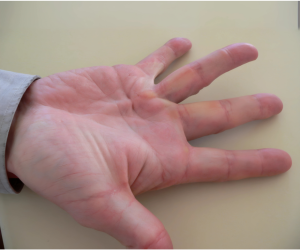
What Is Dupuytren’s Contracture: A Guide to Symptoms and Solutions
What Is Dupuytren’s Contracture: A Guide to Symptoms and Solutions
by Martiele P. Swanko
Dupuytren’s contracture (Dupuytren’s disease) is a progressive hand condition in which scar-like tissue builds up in the palm, forming nodules and cords that can bend the fingers. Estimates vary by age and how it’s measured, but U.S. data suggest about 1% of adults report a doctor’s diagnosis and up to ~7% report symptoms, with higher risk in older adults and those of Northern-European ancestry. Lifestyle factors like smoking and heavy alcohol use are linked with greater risk.
Recognizing symptoms & Getting diagnosed
Early signs include small, firm nodules in the palm (often near the ring or small finger). Over time they may thicken into cords that pull fingers toward the palm, making it hard to lay the hand flat or do fine tasks like buttoning a shirt. The Hueston tabletop test—placing your palm flat on a table—is a simple, recognized check; inability to do so suggests contracture. Diagnosis is usually made by physical exam; ultrasound is not typically required.
Conditions that can mimic Dupuytren’s include trigger finger (a catching/locking tendon) and carpal tunnel syndrome (numbness/tingling from nerve compression). Unlike rheumatoid arthritis, Dupuytren’s affects the palmar fascia (connective tissue), not the joints themselves. Authoritative hand-surgery sources emphasize nodules/cords in the palm and progressive finger flexion as key clues.
Conventional solutions
Care ranges from watchful waiting (if function is good) to procedures that release cords:
Minimally invasive
- Collagenase (Xiaflex) injection (CCH): In clinical studies, ~57–70% of MCP joints reach near-full extension by 30–90 days; PIP joints respond less. Recurrence is common over time.
- Needle fasciotomy (percutaneous aponeurotomy): Quick recovery; higher long-term recurrence than surgery in some series. In longer follow-up, outcomes can be similar to CCH for single-digit disease.
- Surgery
Limited fasciectomy/dermofasciectomy: Often provides more durable correction, with higher complication risk and longer rehab than minimally invasive options.
After any procedure, hand therapy (and sometimes short-term splinting) helps regain motion; follow your therapist’s protocol.
Supportive wellness approaches
My upcoming Dupuytren’s Contracture Solutions Handbook explores whole-person strategies—anti-inflammatory eating, smoking/alcohol reduction, and habits that support overall tissue health. Some people find castor-oil massage or similar comfort measures soothing. Evidence for these approaches in changing disease progression is limited, so treat them as supportive, not curative, and discuss any plan with your clinician.
Next steps
- See a hand specialist to confirm the diagnosis and discuss the best option for your stage.
- Join our community: https://www.facebook.com/groups/dupuytrensolutionsandhealth
- Updates & resources: https://dupuytrenssolutions.com
- Related reads on my site: [Link to Article 2: Early Signs of Dupuytren’s Contracture] · [Link to Article 4: Non-Surgical Treatments] · [Link to Article 15: Collagenase Injections] · [Link to Article 53: Xiaflex Injection]
Disclaimer
Dupuytren’s Solutions is an educational resource. I’m a Dupuytren’s patient and investigative reporter, not a medical professional. This content is for information only and isn’t medical advice. Always consult your healthcare provider before starting, stopping, or changing any therapy, exercise, medication, or supplement. For urgent symptoms, call 911 or seek emergency care.
About the Author
Martiele P. Swanko is a Dupuytren’s patient and investigative reporter, author of the forthcoming Dupuytren’s Contracture Solutions Handbook, and founder of dupuytrenssolutions.com, created to empower the Dupuytren’s community with conventional, alternative, and root-cause solutions.
References
- Mayo Clinic. Dupuytren’s Contracture Overview. https://www.mayoclinic.org/diseases-conditions/dupuytrens-contracture/symptoms-causes/syc-20371943
- Cleveland Clinic. Dupuytren’s Contracture. https://my.clevelandclinic.org/health/diseases/16941-dupuytrens-contracture
- American Academy of Orthopaedic Surgeons (AAOS). Dupuytren’s Disease. https://orthoinfo.aaos.org/en/diseases–conditions/dupuytrens-disease/
- NIH/PMC. Dupuytren’s treatment outcomes (review). https://pmc.ncbi.nlm.nih.gov/
- Dupuytren Research Group. Research Insights. https://www.dupuytrens.org/research-insights/







